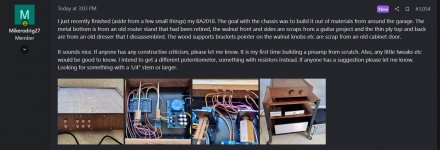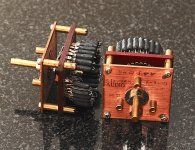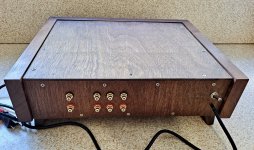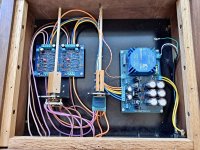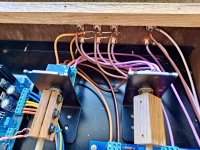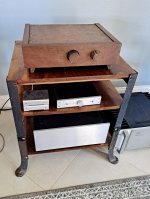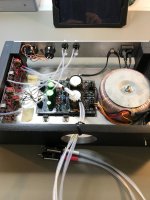Yes...It is far better to use the DIYaudio download facility. Doing so establishes a permanent inclusion in the thread whereas many
pics in older threads loaded via an external facility disappear in time. Makes attempting to follow such threads difficult or in some cases impossible
when schematics disappear. If you open the Attach files button (left hand side below the text box and choose your pic. it is very easy to do...)
I attach a pic of some attenuators as an example.
From the text though along with responses from others you have clearly built a very nice BA18.
pics in older threads loaded via an external facility disappear in time. Makes attempting to follow such threads difficult or in some cases impossible
when schematics disappear. If you open the Attach files button (left hand side below the text box and choose your pic. it is very easy to do...)
I attach a pic of some attenuators as an example.
From the text though along with responses from others you have clearly built a very nice BA18.

Attachments
Okay awesome thanks guys I will do that when I get home. I don't think I'll be able to edit the post but I will just repost the pics
Okay, these are the images from my earlier post #3054. I uploaded them on DIYaudio so that they won't get lost as suggested. Thanks for everything guys!
View attachment 1005755View attachment 1005756View attachment 1005757View attachment 1005758
What are the wooden looking pieces in the two middle internal shot photos? Thanks.
Hey Now,
Another one lives. I’m pleased to say it worked perfectly from first power up. Adjusted DC offset and it’s been playing ever since. Amazing sound. It’s just jury rigged at the moment. I’m making it as a gift for my son, a nice little four input w/ MM phono, relay volume and selector. Finished power wiring so on to ins and outs. Boy it does sound good, you know it when you find yourself listening to a known track and hearing it like with fresh ears.

Another one lives. I’m pleased to say it worked perfectly from first power up. Adjusted DC offset and it’s been playing ever since. Amazing sound. It’s just jury rigged at the moment. I’m making it as a gift for my son, a nice little four input w/ MM phono, relay volume and selector. Finished power wiring so on to ins and outs. Boy it does sound good, you know it when you find yourself listening to a known track and hearing it like with fresh ears.
Zen,shaft couplers
Thanks for the info.
Going back and looking at the photos it is now clear, the one on the left (third pic), I can see how it is coupled, but the one on the right still looks like a cover to me. But since you have the brains, I will go with what you stated.
The one on the left for the for the volume pot was for a splined shaft. The input switcher had a shaft with a flat spot on, like how you would use a set screw to drive into. On the other side of the block are two screws, one to go into the wood shaft and one to hit the flat spot on the input selector shaft.
I hope that makes sense.
Billyk, that looks like it is going to be a very nice preamp. I bet your son ends up really liking it.
I hope that makes sense.
Billyk, that looks like it is going to be a very nice preamp. I bet your son ends up really liking it.
Just a quick revision on my linestage. Aquired some certified pre-owned Tempo Electric Big Twist solid silver interconnects (24 gauge). Needed a different length so went ahead and did a teardown and rebuild to work with my pre. Used some 11 gauge semi-clear Teflon jacket, because I liked the look mainly, and works well inside and out. No impressions yet, system always sounds weird for awhile as things settle back in after changes like this... No volume control or input switching needed for my own use, only need the extra gain for my amps. Linestage looks ugly, but is hidden behind my monoblocks anyhow. Plan to do a full dual mono renovation someday, in a larger chassis.
Attachments
All done but for some tidying up here and there. Oh and a TT ground binding post I forgot about.
All but the output cabling from the jack to the RCAs in the back.

Here it is playing beautiful music. Wow I’m very happy with the sound. I’m going to compare them all this, Korg B1, ACP+. WooHoo.

All but the output cabling from the jack to the RCAs in the back.
Here it is playing beautiful music. Wow I’m very happy with the sound. I’m going to compare them all this, Korg B1, ACP+. WooHoo.
Just a comment here. There is definitely something to the whole "better wire, caps, connectors, etc" thing, It's a bit subtle with my own experience, but real. Your ears / brain are more sensitive in a way that current test equipment is not showing us. Not a place to spend big money though unless the rest of the system is quite revealing and refined, capable of showing these small differences. Differences are more clarity, micro detail, and resolution. But in a more relaxed, less fatiguing way. The sytem feels faster, leading edges are more direct, more natural, more like the real thing and less like playback equipment. Better caps, cable, etc. don't "sound better", they just do a better job "getting out of the way" it seems.
The entire system is a chain. It's worth paying attention to every link IMO. If the highest performance is the goal. Everything matters, just some things more than others obviously. For example swapping out the electrolytic coupling caps in my amps for VCAP's made a bigger difference than the solid silver in oversized teflon interconnects. Sure you can have a fine sounding system with lamp cord speaker wire and throw away junk interconnects. But you won't be getting everything your hardware is really capable of, if that hardware is upper level, like a lot of the projects around here. Certainly Wayne's preamp.
The entire system is a chain. It's worth paying attention to every link IMO. If the highest performance is the goal. Everything matters, just some things more than others obviously. For example swapping out the electrolytic coupling caps in my amps for VCAP's made a bigger difference than the solid silver in oversized teflon interconnects. Sure you can have a fine sounding system with lamp cord speaker wire and throw away junk interconnects. But you won't be getting everything your hardware is really capable of, if that hardware is upper level, like a lot of the projects around here. Certainly Wayne's preamp.
I whole heartily agree.
I am the fortunate owner of Sony VFet #108. I try to get the most value out of what I put in my system. Sometimes that means an expensive cap or a pricey semiconductor (looking at you 2sk!!) but a lot of time a good component is the right choice. It is a balancing act for sure. One of the things that helped my system a whole lot was room treatments. Amazed at the improvement. I found the canare interconnects I make sound pretty darn great now that I think I can hear the difference; they are quite good but hardly esoteric. It's a journey for sure. . .
I am the fortunate owner of Sony VFet #108. I try to get the most value out of what I put in my system. Sometimes that means an expensive cap or a pricey semiconductor (looking at you 2sk!!) but a lot of time a good component is the right choice. It is a balancing act for sure. One of the things that helped my system a whole lot was room treatments. Amazed at the improvement. I found the canare interconnects I make sound pretty darn great now that I think I can hear the difference; they are quite good but hardly esoteric. It's a journey for sure. . .
Room acoustics are a huge one. Usually the last thing people think about (or not at all), when it should be the first. A properly treated room, helps a ton with the whole "but I can't hear a difference!" thing. My room has early reflection absorption at the side walls and ceiling, and as much velocity based absorption as I could get away with in my corners for low end control. It's far from perfect, but huge improvement over nothing. It still has to function as a living room though, so there was some compromise there.
I am not familiar with the Canare interconnects. But if they are similar to the Belden coax style Blue Jeans Cable LC-1's I just replaced, the cabling I described above is a real step up.
I am not familiar with the Canare interconnects. But if they are similar to the Belden coax style Blue Jeans Cable LC-1's I just replaced, the cabling I described above is a real step up.
Yes, room treatments are crucial. To appreciate these minor tweaks that we do to these amps, a good platform like a treated room is so important. I really enjoy watching Anthony Grimani on youtube. He has done a ton of webinars with a lot of very detailed information on room treatments and other aspects of home audio.
I have 7 4" thick medium to medium large sized absorbers in my medium sized living room. I hang them with just a drywall nail and picture hanger wire as they are pretty light. Because of this, they are easy to move around and try things out. I want to mess around with diffusion.
Anthony Grimani's rule of thumb for wall coverage is 13% absorption and 13% absorption. Diffusers generally need to be at least 6" thick to start to provide good value, absorbers around 4" or thicker.
The wonderfull thing is the imaging and sense of the space that the recording is in is much more real sounding. You hear their room decay vs your own mixed with theirs, peaks nulls etc.
One thing that Anthony talked about that I thought was interesting is that he tries to make it so treatment isn't symmetrical. My room isn't symmetrical so I haven't been able to test this theory but that is some good information as I see a lot of rooms that are matchy matchy.
I have 7 4" thick medium to medium large sized absorbers in my medium sized living room. I hang them with just a drywall nail and picture hanger wire as they are pretty light. Because of this, they are easy to move around and try things out. I want to mess around with diffusion.
Anthony Grimani's rule of thumb for wall coverage is 13% absorption and 13% absorption. Diffusers generally need to be at least 6" thick to start to provide good value, absorbers around 4" or thicker.
The wonderfull thing is the imaging and sense of the space that the recording is in is much more real sounding. You hear their room decay vs your own mixed with theirs, peaks nulls etc.
One thing that Anthony talked about that I thought was interesting is that he tries to make it so treatment isn't symmetrical. My room isn't symmetrical so I haven't been able to test this theory but that is some good information as I see a lot of rooms that are matchy matchy.
- Home
- Amplifiers
- Pass Labs
- Wayne's BA 2018 linestage
